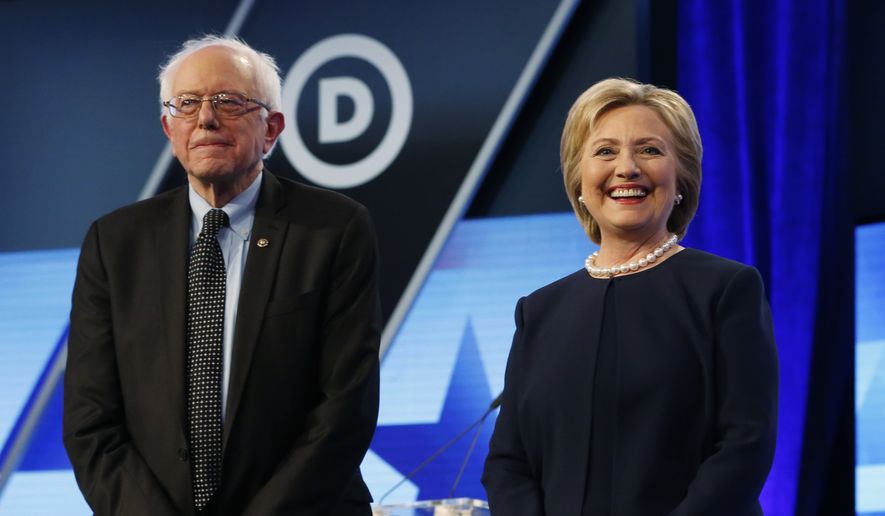With his words, actions and personal checkbook, then-Sen. Barack Obama in 2008 moved past a bitter primary fight and acted quickly to mend fences with Hillary and Bill Clinton, offering a template for Mrs. Clinton and Sen. Bernard Sanders as they try to unify the Democratic Party during this crucial post-primary, pre-convention period.
Mrs. Clinton and Mr. Sanders are set to meet Tuesday in what’s likely to be the first step in a multipart process of bringing the factions together and getting all Democrats on board the anti-Donald Trump effort.
While the primary battle between the former first lady and the Vermont senator was often ugly and at times personal, analysts and progressive leaders say they expect the two to work together over the next months, despite Mr. Sanders’ promise to campaign until the party convention in July.
“I would expect Clinton and Sanders to have some joint appearances and to have a peaceful relationship. The 2008 situation provides a good role model for Democrats. Obama and Clinton were able to bury the hatchet, and this put the party on strong footing for the fall campaign,” said Darrell M. West, director of governance studies at the Brookings Institution. “I expect Clinton and Sanders will have a successful partnership because of their interest in stopping Trump.”
But there’s a sense that the rift between the Clinton and Sanders teams is deeper and more ideological than the splits that existed in 2008. Mr. Sanders has characterized Mrs. Clinton as the embodiment of the political establishment and has suggested she’s beholden to Wall Street. He’s also questioned her judgment, citing her 2002 vote to authorize the Iraq War, among other things.
Mr. Sanders’ criticism has given many Democrats reasons to be skeptical of Mrs. Clinton. Polls consistently have shown that many Democrats simply don’t see Mrs. Clinton as honest and trustworthy, and the two candidates may find it difficult to alleviate those concerns and fully unify the party.
The next several weeks will be critical in repairing the relationship between Mrs. Clinton and Mr. Sanders. More importantly, how the two interact could impact whether Sanders supporters — some of whom have vowed never to vote for Mrs. Clinton — put the past behind them and support the former first lady.
Mr. Obama’s actions in the summer of 2008 offer some guidance for bridging the divide.
Shortly after Mrs. Clinton dropped out of the race that year, she endorsed Mr. Obama and appeared on a campaign stage alongside him. Immediately afterwards, Mr. Obama took a series of steps to move past the primary battle.
In late June 2008 Mr. Obama wrote a $2,300 personal check to Mrs. Clinton to go toward paying down her campaign debt. The move was described by both sides as a goodwill gesture.
Also, in June of that year, the Obama campaign hired former Clinton campaign manager Patti Solis Doyle as its own chief of staff to the presidential nominee, opening the door for other Clinton aides to join the Obama team as it prepared for the general election.
At the same time, Obama and Clinton campaign leaders were meeting behind the scenes to repair the strained relationship between the two sides.
By the end of June, Mr. Obama also personally reached out to former President Clinton to squash the supposed grudges that existed between the two men. Mr. Clinton famously said he believed the Obama campaign had played the “race card” against him and reportedly harbored bitterness toward Mr. Obama.
Mr. Obama’s phone call to Mr. Clinton seemed to de-escalate those tensions. Mr. Obama later went out of his way to compliment both Mr. and Mrs. Clinton, and to make clear he needed both of them on his side.
During a July 2008 appearance on NBC’s “Meet the Press,” he called the Clintons an incomparable campaign duo that was crucial to Democratic success.
“I think that not only do I want Hillary Clinton campaigning with me, I want Bill Clinton, one of the smartest men in the history of politics, involved in our campaign,” Mr. Obama said. “I would love to have Bill Clinton campaigning for me. He was very effective when it came to our primary, you know. He was traveling to little towns in Texas and Ohio, and it was very hard to keep up, given that he was campaigning so hard at the same time as Hillary was campaigning as hard as she was.”
Ultimately, both Clintons gave ringing endorsements to Mr. Obama at the party convention and would actively campaign for him throughout the fall, leading up to his victory over Republican Sen. John McCain in the November election.
This cycle, progressive leaders say the best way to achieve unity is for Mrs. Clinton to fully embrace the liberal principles put forth by Mr. Sanders.
Making issues such as Social Security expansion, debt-free college, and tougher Wall Street reform centerpieces of her campaign will make it much more likely Mrs. Clinton can garner the full support of Mr. Sanders and his highly motivated supporters, according to Adam Green, co-founder of the powerful advocacy group the Progressive Change Campaign Committee.
“The immediate challenge is not winning over Bernie Sanders himself but wooing the hearts and minds of his millions of grass-roots supporters,” Mr. Green said. Would Mrs. Clinton “continue talking about the progressive positions she’s taken so far when the primary is over. These next two weeks are a golden opportunity to answer that question.”
• Ben Wolfgang can be reached at bwolfgang@washingtontimes.com.




Please read our comment policy before commenting.